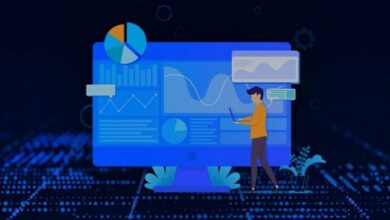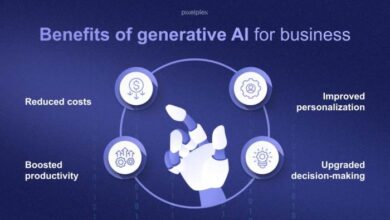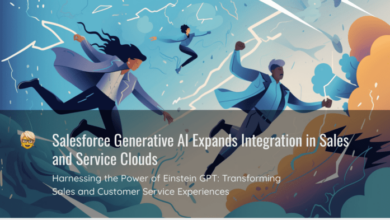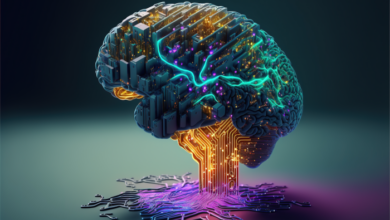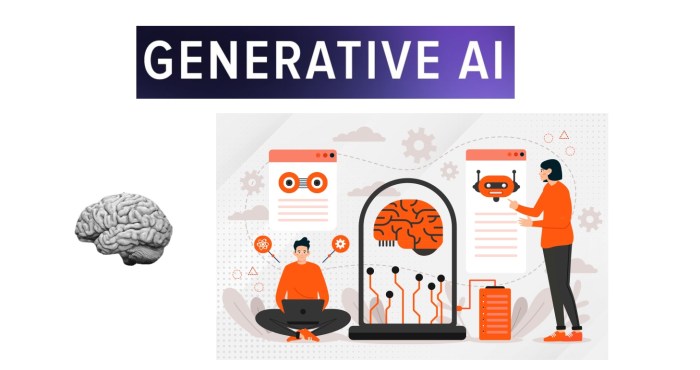
What is Generative AI: A New Era of Content Creation
What is generative AI? It’s a revolutionary technology that’s changing the way we create content, from art and music to text and code. Imagine a world where machines can learn from existing data and then generate entirely new, original content that’s indistinguishable from human-made work.
This is the promise of generative AI, and it’s already starting to reshape industries across the globe.
At its core, generative AI utilizes advanced algorithms and machine learning techniques to analyze patterns and relationships within massive datasets. By understanding these patterns, the models can then generate new data that shares similar characteristics, creating content that’s both creative and innovative.
From crafting realistic images and composing captivating melodies to writing engaging stories and even generating functional code, the applications of generative AI are vast and rapidly expanding.
Introduction to Generative AI
Generative AI is a type of artificial intelligence that focuses on creating new content, such as text, images, audio, and video, based on existing data. It’s like having a digital artist that can learn from your favorite paintings and create new masterpieces in the same style.Generative AI models learn patterns and relationships within the data they are trained on, enabling them to generate new outputs that share similar characteristics.
This process is often described as “learning the language of the data” and then using that knowledge to create something new.
Real-World Applications of Generative AI
Generative AI has a wide range of applications across various industries. Here are some examples:
- Text Generation:Generative AI models can write articles, poems, scripts, and even code. Tools like Kami and Bard demonstrate this capability.
- Image Generation:AI models like DALL-E 2 and Stable Diffusion can create realistic images from text descriptions. Imagine describing a “portrait of a cat wearing a top hat” and the AI generates a stunning image based on your words.
- Music Composition:Generative AI can compose music in various styles, from classical to pop. This technology is used in tools like Amper Music and Jukebox.
- Drug Discovery:AI models can design new drug molecules by predicting their properties and effectiveness, accelerating the drug discovery process.
Differences Between Generative AI and Traditional AI
Generative AI differs from traditional AI in its focus and capabilities:
- Traditional AI:Focuses on analyzing existing data to make predictions or classifications. For example, classifying emails as spam or identifying patterns in customer behavior.
- Generative AI:Goes beyond analyzing data and aims to create new content based on the learned patterns. It’s about generating novel outputs rather than simply analyzing existing ones.
How Generative AI Works
Generative AI is not magic; it’s a sophisticated combination of algorithms and techniques that enable machines to create new content. These models learn from existing data and then use that knowledge to generate new outputs that share similar characteristics.
Understanding the Algorithms
Generative AI models are built upon various algorithms, each with its unique approach to learning and generating content. Some of the most common algorithms include:
- Generative Adversarial Networks (GANs):GANs consist of two neural networks: a generator and a discriminator. The generator creates new data, while the discriminator tries to distinguish between real and generated data. Through this adversarial process, both networks improve, leading to increasingly realistic outputs.
- Variational Autoencoders (VAEs):VAEs compress data into a lower-dimensional representation called a latent space. This latent space captures the essential features of the data, allowing the model to generate new data by sampling from this space.
- Diffusion Models:Diffusion models start with noisy data and gradually remove the noise to create realistic outputs. They learn to reverse the process of adding noise, allowing them to generate data that resembles the training data.
How Generative Models Learn from Data
Generative models learn from vast amounts of data, capturing patterns and relationships within that data. This process, known as training, involves feeding the model examples of the type of content it’s supposed to generate. For example, a text-generating model might be trained on a massive dataset of books, articles, and websites.
The Concept of Latent Space
The latent space is a crucial concept in generative AI. It’s a lower-dimensional representation of the data, capturing the essential features and relationships within the data. Think of it as a compressed version of the original data, containing the essence of what makes it unique.For example, a latent space for images might represent the features of a dog, like its size, fur color, and breed.
By sampling from this latent space, a generative model can create new images of dogs that resemble those in the training data but with variations in these features.
Types of Generative AI
Generative AI models are classified into various categories based on their functionalities, training data requirements, and performance metrics. Each type of generative AI model has its own strengths and limitations, making them suitable for specific applications.
Generative Adversarial Networks (GANs)
Generative Adversarial Networks (GANs) are a type of generative model that use two neural networks, a generator and a discriminator, to learn the distribution of training data and generate new data samples. The generator network learns to create realistic data samples, while the discriminator network learns to distinguish between real and generated data.
Generative AI is like a culinary artist, able to create something entirely new from existing ingredients. Think of it like crafting the perfect caramelized onion breakfast sandwiches – the AI takes your input, processes it, and outputs a delicious and unique creation.
Just as a skilled chef blends flavors and textures, generative AI combines data and algorithms to produce novel outputs, from images and text to music and code.
- Strengths: GANs are known for their ability to generate high-quality, realistic data samples, especially in areas like image generation and video synthesis. They can be trained on a variety of data types, including images, text, and audio.
- Limitations: GANs can be challenging to train and require careful hyperparameter tuning. They can also be susceptible to mode collapse, where the generator network generates only a limited number of data samples.
Variational Autoencoders (VAEs)
Variational Autoencoders (VAEs) are another type of generative model that use a probabilistic approach to learn the underlying distribution of data. They work by encoding input data into a lower-dimensional latent space and then decoding it back into the original space.
VAEs can be used to generate new data samples by sampling from the learned latent space.
- Strengths: VAEs are generally easier to train than GANs and are less prone to mode collapse. They can also be used for tasks such as image reconstruction and data compression.
- Limitations: VAEs often generate less realistic data samples than GANs, particularly for complex data distributions. They can also be sensitive to the choice of prior distribution.
Diffusion Models
Diffusion models are a relatively new type of generative model that have gained popularity in recent years. They work by gradually adding noise to the training data and then learning to reverse the process to generate new data samples. Diffusion models have shown promising results in generating high-quality images and audio.
- Strengths: Diffusion models are known for their ability to generate high-quality, diverse data samples. They are also less prone to mode collapse than GANs and VAEs.
- Limitations: Diffusion models can be computationally expensive to train, especially for high-resolution data. They also require a large amount of training data.
Language Models
Language models are generative AI models specifically designed for text generation. They are trained on massive datasets of text and learn to predict the next word in a sequence, enabling them to generate coherent and grammatically correct text.
- Strengths: Language models excel at generating human-like text, translating languages, summarizing documents, and answering questions. They are also capable of creating different creative text formats, such as poems, scripts, musical pieces, email, letters, etc.
- Limitations: Language models can sometimes generate biased or offensive text, reflecting the biases present in the training data. They may also struggle with factual accuracy and can be susceptible to generating nonsensical or illogical text.
Comparison Table
| Model Type | Applications | Training Data Requirements | Performance Metrics |
|---|---|---|---|
| Generative Adversarial Networks (GANs) | Image generation, video synthesis, data augmentation | Large datasets of high-quality data | Inception Score (IS), Fréchet Inception Distance (FID) |
| Variational Autoencoders (VAEs) | Image reconstruction, data compression, anomaly detection | Moderate datasets of data | Reconstruction error, Kullback-Leibler divergence (KL) |
| Diffusion Models | Image generation, audio generation, text-to-image synthesis | Large datasets of data | Fréchet Inception Distance (FID), Peak Signal-to-Noise Ratio (PSNR) |
| Language Models | Text generation, language translation, text summarization, question answering | Massive datasets of text | Perplexity, BLEU score, ROUGE score |
Applications of Generative AI
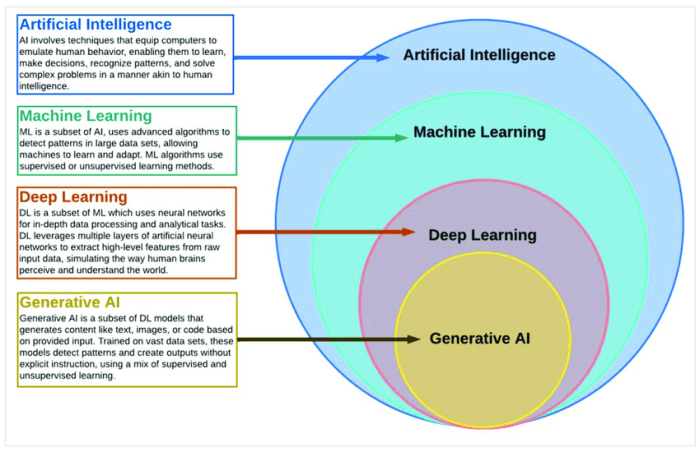
Generative AI is not just a technological marvel; it’s a transformative force across numerous industries, revolutionizing the way we create, design, and solve problems. From crafting stunning artwork to automating complex tasks, generative AI is leaving an indelible mark on our world.
Generative AI is like a digital artist, creating new content from existing data. It’s constantly learning and evolving, just like the beautiful mess of life, which is what I love about the A Beautiful Mess Zooey magazine. Their focus on creativity and real-life experiences reminds me of the way generative AI can capture the essence of our world in new and unexpected ways.
Generative AI in Creative Fields
Generative AI is changing the landscape of creative industries, empowering artists, musicians, and writers with new tools and possibilities.
- Art:Generative AI algorithms can create unique and captivating art pieces, from abstract paintings to photorealistic images. For example, the DALL-E 2 model can generate images from text prompts, enabling artists to explore new artistic styles and concepts.
- Music:Generative AI can compose original music pieces, generate melodies, and even create entire soundtracks. Platforms like Amper Music use AI to create custom music for various purposes, including film scores, video game soundtracks, and advertising.
- Writing:Generative AI models can assist writers in generating content, brainstorming ideas, and even writing full-fledged articles or stories. Tools like Jasper and Copy.ai help writers overcome writer’s block and generate engaging content for various formats, including blog posts, social media captions, and marketing copy.
Generative AI in Healthcare
Generative AI is transforming healthcare by enabling faster diagnosis, personalized treatments, and drug discovery.
- Medical Imaging:Generative AI models can analyze medical images like X-rays and CT scans, identifying abnormalities and assisting radiologists in making accurate diagnoses. For instance, AI-powered systems can detect tumors and other lesions in medical images with high accuracy, improving early detection and treatment outcomes.
- Drug Discovery:Generative AI can accelerate drug discovery by simulating the behavior of molecules and predicting their interactions with biological targets. AI-powered drug discovery platforms are being used to identify promising drug candidates, potentially leading to faster development of new therapies.
- Personalized Medicine:Generative AI can create personalized treatment plans based on individual patient data, including medical history, genetic information, and lifestyle factors. AI models can predict treatment responses and identify potential side effects, leading to more effective and tailored healthcare interventions.
Generative AI in Finance
Generative AI is revolutionizing the financial industry by automating tasks, improving risk assessment, and enhancing customer service.
Generative AI is all about creating new content, whether it’s text, images, or even music. It’s like having a creative partner that can help you brainstorm ideas. For example, if you’re looking for a fun DIY project, generative AI could suggest an easy hanging planter DIY that’s perfect for your space.
And once you’ve finished, generative AI can even help you write a blog post about your experience, making the whole process even smoother.
- Fraud Detection:Generative AI models can analyze financial transactions and identify suspicious patterns, helping banks and financial institutions detect and prevent fraudulent activities. AI-powered fraud detection systems can learn from past fraudulent transactions and identify new patterns, improving the accuracy and efficiency of fraud prevention efforts.
- Risk Management:Generative AI can be used to model financial markets and predict potential risks, enabling investors and financial institutions to make more informed decisions. AI-powered risk management tools can analyze vast amounts of data and identify emerging risks, helping to mitigate potential losses.
- Customer Service:Generative AI-powered chatbots can provide personalized and efficient customer service, answering questions and resolving issues 24/7. AI chatbots can handle a wide range of customer inquiries, freeing up human agents to focus on more complex tasks.
Generative AI in Education
Generative AI is transforming education by creating personalized learning experiences, automating tasks, and providing new ways to engage students.
- Personalized Learning:Generative AI can create personalized learning paths for each student, adapting to their individual learning styles and pace. AI-powered tutoring systems can provide tailored feedback and support, helping students learn at their own pace and achieve their full potential.
- Content Creation:Generative AI can create educational content, such as quizzes, assignments, and even entire courses. AI models can generate engaging and relevant content, tailored to specific learning objectives and student needs.
- Automated Grading:Generative AI can automate the grading of assignments and tests, freeing up teachers to focus on other tasks, such as providing personalized feedback and supporting students. AI-powered grading systems can provide objective and consistent assessments, ensuring fairness and accuracy.
Challenges and Ethical Considerations
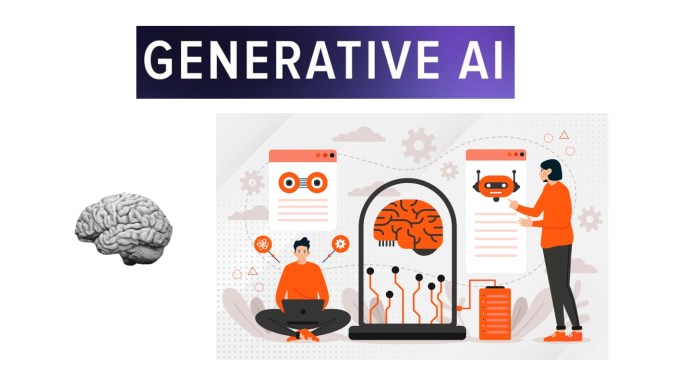
Generative AI, with its remarkable capabilities, also presents a range of challenges and ethical considerations that require careful attention. The potential for misuse, the perpetuation of biases, and the spread of misinformation are just some of the concerns that need to be addressed.
Bias in Generative AI
Bias in generative AI is a significant concern. Generative AI models are trained on massive datasets, which may reflect and amplify existing societal biases. This can lead to the generation of content that perpetuates stereotypes, discrimination, and harmful generalizations.
For example, a text generator trained on a dataset with biased language might produce text that reinforces gender stereotypes or racial prejudice.
- Data Bias:The training data used for generative AI models can contain biases, which are then reflected in the model’s outputs. For example, a language model trained on a dataset with predominantly male authors might generate text that perpetuates gender stereotypes.
- Algorithmic Bias:The algorithms used in generative AI models can also introduce bias. For example, a facial recognition system trained on a dataset with predominantly white faces might perform poorly on people with darker skin tones.
- Amplification of Bias:Generative AI models can amplify existing biases in the data they are trained on, leading to the generation of content that is even more biased than the original data.
Misinformation and Deepfakes
Generative AI can be used to create realistic and convincing fake content, including images, videos, and audio. This raises concerns about the spread of misinformation and the potential for malicious use. Deepfakes, for example, are synthetic media that can be used to create fake videos of real people, which can be used for political manipulation, defamation, or harassment.
- Creation of Fake Content:Generative AI can be used to create realistic fake content, such as images, videos, and audio, which can be used to spread misinformation or deceive people.
- Deepfakes:Deepfakes are synthetic media that can be used to create fake videos of real people. These videos can be used for political manipulation, defamation, or harassment.
- Difficulty in Detection:It can be difficult to distinguish between real and fake content generated by generative AI, especially as the technology continues to advance.
Potential for Misuse, What is generative ai
Generative AI has the potential for misuse in various ways. It can be used to create malicious content, such as spam, phishing emails, or propaganda. It can also be used to generate fake reviews, impersonate individuals, or create counterfeit goods.
- Spam and Phishing:Generative AI can be used to create convincing spam emails or phishing attacks, which can deceive users into giving up sensitive information.
- Propaganda and Disinformation:Generative AI can be used to create and spread propaganda or disinformation, which can be used to influence public opinion or sow discord.
- Counterfeit Goods:Generative AI can be used to create counterfeit goods, such as fake designer handbags or clothing, which can be used to defraud consumers.
Strategies for Mitigating Risks
Addressing the challenges and ethical considerations associated with generative AI requires a multi-pronged approach. This includes developing responsible AI guidelines, promoting transparency, and fostering collaboration between researchers, developers, and policymakers.
- Develop Responsible AI Guidelines:Organizations and governments should develop and implement responsible AI guidelines that address issues such as bias, fairness, transparency, and accountability.
- Promote Transparency:Developers should be transparent about the data used to train their models, the algorithms used, and the potential risks and limitations of their systems.
- Foster Collaboration:Researchers, developers, policymakers, and other stakeholders should collaborate to address the challenges and ethical considerations associated with generative AI.
- Develop Detection Mechanisms:Researchers are working on developing tools and techniques to detect fake content generated by generative AI, such as deepfake detection algorithms.
- Educate Users:Users should be educated about the potential risks and limitations of generative AI, and how to identify and avoid fake content.
Future of Generative AI: What Is Generative Ai
Generative AI is a rapidly evolving field with immense potential to transform various aspects of our lives. The ongoing advancements and future trends in generative AI research are paving the way for groundbreaking applications and innovations across industries.
Advancements in Generative AI Research
The field of generative AI is constantly evolving, with researchers pushing the boundaries of what’s possible. Some of the key advancements driving the future of generative AI include:
- Improved Model Architectures:Researchers are developing more sophisticated model architectures, such as transformers and diffusion models, that can generate higher-quality and more realistic outputs. These models are capable of learning complex patterns and relationships in data, enabling them to generate more diverse and creative outputs.
- Enhanced Training Data:The availability of massive datasets is crucial for training generative AI models. Researchers are exploring new ways to collect and curate large-scale datasets, including synthetic data generation and data augmentation techniques. This abundance of data allows models to learn more effectively and generate more diverse and accurate outputs.
- Integration with Other AI Technologies:Generative AI is being integrated with other AI technologies, such as reinforcement learning and computer vision, to create more powerful and versatile applications. For instance, generative adversarial networks (GANs) can be combined with reinforcement learning to create agents that can learn to generate optimal strategies in complex environments.
Impact of Generative AI on Various Aspects of Our Lives
Generative AI has the potential to revolutionize various aspects of our lives, from the way we create art and music to the way we interact with technology. Some of the potential impacts include:
- Personalized Experiences:Generative AI can create personalized experiences in various domains, such as education, healthcare, and entertainment. For example, AI-powered tutors can generate customized learning materials based on a student’s individual needs and learning style. Similarly, AI-powered healthcare systems can generate personalized treatment plans based on a patient’s medical history and genetic information.
- Enhanced Creativity:Generative AI can empower individuals to express their creativity in new and innovative ways. For example, AI-powered tools can assist artists in generating new ideas, creating unique artwork, and composing music. These tools can help artists overcome creative blocks and explore new creative possibilities.
- Increased Efficiency and Productivity:Generative AI can automate tasks and processes, leading to increased efficiency and productivity across industries. For example, AI-powered chatbots can handle customer inquiries, freeing up human agents to focus on more complex tasks. Similarly, AI-powered tools can generate code, reports, and other documents, reducing the time and effort required for these tasks.
Potential for New Applications and Breakthroughs
The future of generative AI is filled with exciting possibilities for new applications and breakthroughs. Some of the potential areas of focus include:
- Scientific Discovery:Generative AI can accelerate scientific discovery by generating new hypotheses, designing experiments, and analyzing complex data. For example, AI-powered tools can help researchers identify potential drug candidates, design new materials, and understand the mechanisms of complex biological systems.
- Virtual and Augmented Reality:Generative AI can create realistic and immersive virtual and augmented reality experiences. For example, AI-powered tools can generate realistic 3D models of objects and environments, enabling users to interact with virtual worlds in more engaging and meaningful ways.
- Personalized Medicine:Generative AI can revolutionize personalized medicine by generating customized treatment plans based on a patient’s individual genetic makeup, lifestyle, and medical history. For example, AI-powered tools can identify potential drug targets, design personalized therapies, and predict disease risk.


